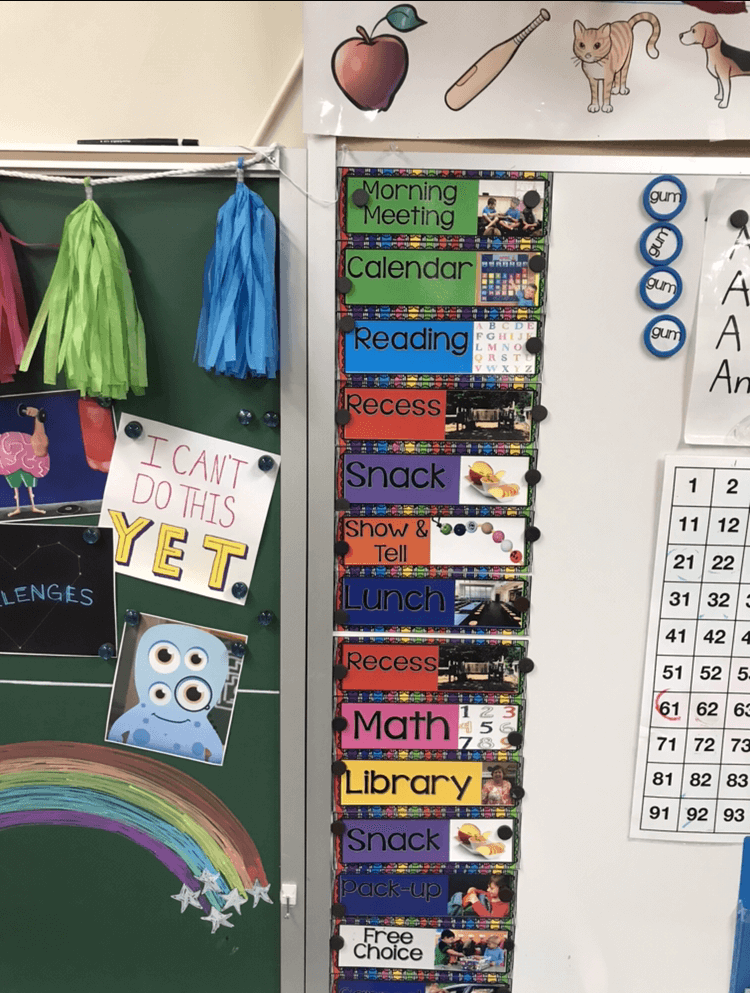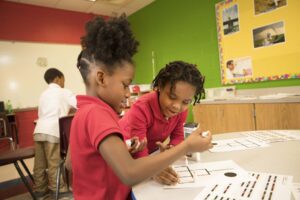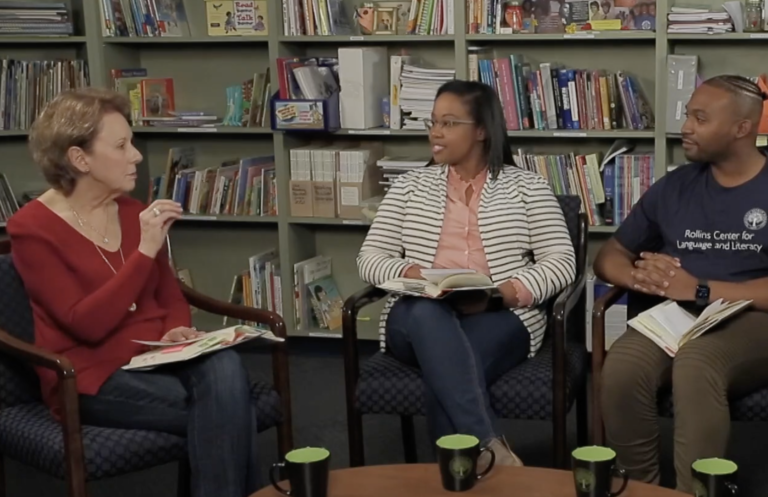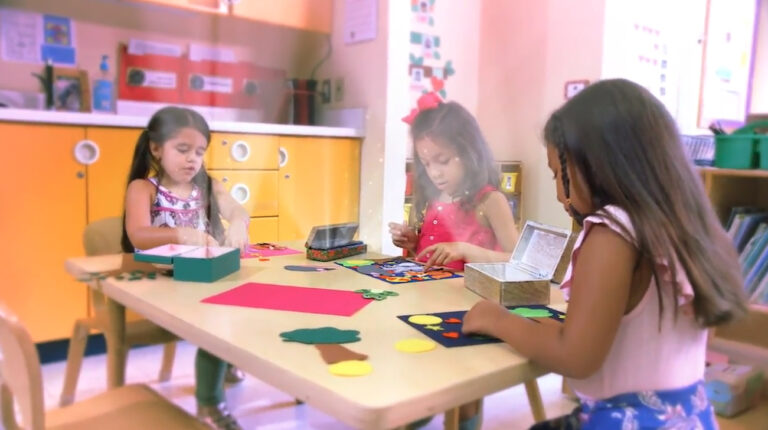It has probably been a while since you sat in a Child Development course in college, but I’m about to bring you right back into that lecture hall with one name – Bronfenbrenner. Sound familiar?
His ecological systems theory explains how a child’s environment influences his development. But he also explains how it’s not just one environment, but an entire ecosystem at play. Every person who interacts with a child impacts that child’s life. Every good experience, every negative experience, every single interaction means something. And for school age children, a significant portion of their time is spent in one particular environment – the school.
What exactly does that mean for your K-3 classroom environment though? And how can you ensure yours lays the foundation for effective teaching and learning to occur?
I can tell you one thing – it’s not just about classroom decorations and festive bulletin boards, it’s about creating the best possible space in our classrooms for learning.
Here are a few key categories that make up the ideal classroom:
Establishing and Fostering Culture
We all want to feel like we belong. It’s one of our most basic needs as people. Without it, we feel lost. So creating a culture of belonging for your students is extremely important. There are a few different ways we can do this in a classroom, such as activities and routines that bind us in groups and engage your students’ brains and nervous systems for learning.
- Transitions, Attention Getters, Cheers and Chants. Using songs, cues, chants, and cheers allows you to maximize instructional time, helps to acknowledge ideal behaviors, and define ideal interactions. Watch these teachers as they use attention grabber chants with their students:
Quick tip: Include your classroom name in a customized chant. You could try something like this: “Classroom K! Listen Up, What’s Up?” Not only do they all know and have a group chant – a shared language – but they also have a shared name. They are all an important piece of Classroom K!
- Modeling of Routines and Procedures Interactively. The “Show Me, Guide Me, Let Me Try” strategy engages students when learning a new activity and gives them the opportunity to observe the use of materials, brainstorm the uses, and practice these expectations in a risk-free setting. Watch as Ms. Peek uses this strategy to explain some new exercises to her classroom:
- Preparing and Having Materials Ready for Instruction. If you’re scrambling to get things prepared, it can be hard to focus and be intentional with your students. Being aware of what is happening in the classroom engages learners and maximizes time for interactions with students and learning.
- Take Time to Reflect. Reflection gives you the opportunity to think about interactions with students. Try using a journal with guiding questions or prompts to reflect about instructional practices and professional goals. You could also video yourself during instruction, and watch it later to work towards your professional goals. You will pick up on new things about your students too!
Classroom Structure
The classroom environment is the backdrop of our learning ecosystem. The more deliberate you are in creating this structure, the more likely you are to have an environment that fuels students love of learning and gives you the opportunity for more effective instruction. And while classroom design is an important part of this structure, it’s not the only part you need to keep in mind.
- Deliberate Classroom Design. Students and teachers need to know how to readily access materials while removing barriers such as disorganization or clutter that may disrupt learning.
- Morning Routine. Morning routines welcome students and establish a positive tone for the day. These meetings also present important opportunities to build stronger social bonds between students and teachers.
- Daily Schedule. Place a visual daily schedule in your classroom to help your students understand what they can expect throughout the day. Make sure there is ample time for transitions, brain breaks, independent reading, and other activities! Quick tip: If there is a change to the schedule, make children aware of these changes in advance if possible.

Equity of Voice
For a person to thrive, we need to feel our voices matter and that we are heard. Every child needs to have the opportunity to speak and, in an ideal classroom ecosystem, time spent speaking should be equal across every student. There are a few ways you can give students opportunities to speak throughout the day:
- Talking With Each Other. Students can engage in meaningful conversation with each other about what they’re learning. This empowers students to formulate their own original ideas.

- Morning Meeting and Closing Circle. Think of these as bookends to your day. You are giving a warm welcome to your children, telling them they’re safe here, they are important here, they belong here. And at the end of the day, you all say goodbye to your classroom community, and that you are excited to see them again tomorrow for another day of learning.
- Personal Development and Social Emotional Learning. This teaches students strategies for conflict resolution and how to interact with one another. In an ideal classroom, these strategies are embedded in activities throughout the day.
These are just a few key elements to make your K-3 classroom a community of learning – a place where children thrive. Learn more about how to create an effective learning ecosystem in our brand new course, “Ecosystems.”
LEARN MORE
A classroom is a community of learning — a “system” of teachers, learners, peers and materials, all working together so learning can thrive. We can call this an ecosystem and it consists of physical elements, routines/procedures, cognitive processes and language opportunities. Intentional, systematic implementation of classroom ecosystem principles is well-established as critical for constructing the reading brain.
Recommended Resources for Creating an Ideal K-3 Classroom
- Incorporating Chimes Into Your Routines and Procedures
- Student Data Profile
- Teacher Journal Prompts
- Morning Routine
- Classroom Planning Guide
- Metacognition Poster
- Accountable Talk Prompts
- Accountable Talk Look Fors
- Show Me, Guide Me, Let Me Try
- Key Points and Tips for Comprehension Instruction
- K-3 Child-Centered Work Spaces and Resources
- K-3 Small Group Instructional Area
- K-3 Whole Group Instructional Area
- K-3 Teacher Planning Area




a system of learning and working together.
I can call this a ecosystem it consists physical elements.
the ecosystem helps to teach the kids games and things to do getter.
teachings student to work together in the classroom
Teacher should work together with the students